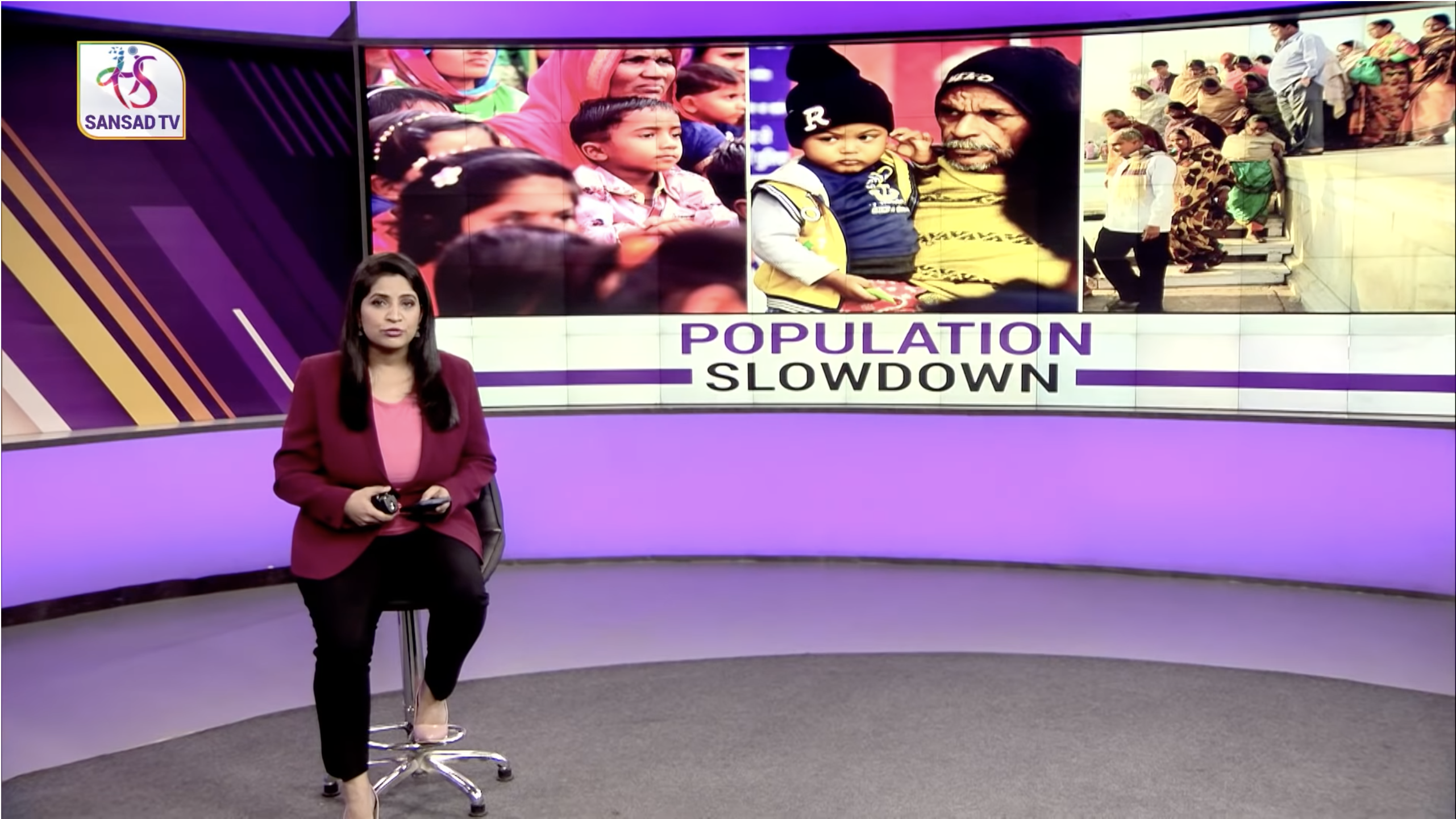In the series Sansad TV Perspective, we bring you an analysis of the discussion featured on the insightful programme ‘Perspective’ on Sansad TV, on various important topics affecting India and also the world. This analysis will help you immensely for the IAS exam, especially the mains exam, where a well-rounded understanding of topics is a prerequisite for writing answers that fetch good marks.
In this article, we feature the discussion on the topic: Population Slowdown.

Anchor: Teena Jha
Participants:
- Dr. J. K. Bajaj, Director, Centre for Policy Studies
- Dr. S.K. Singh, Professor & Head, Department of Mathematical Demography and Statistics, IIPS (International Institute for Population Sciences)
- Poonam Muttreja, Executive Director, Population Foundation of India
Context:
- According to the latest report of the National Family Health Survey, for 2019-2020, the country’s population is set to fall as its total fertility rate has dropped to 2 for the first time ever. In the 2015-16 survey, the national TFR (total fertility rate) was 2.2. In the 2005-06 survey, it was 2.7. Now it has dropped down to 2 which is below the replacement level.
- The replacement level of TFR (total fertility rate) is estimated to be 2.1. The findings suggest that TFR (total fertility rate) has declined to 2.1 in rural areas and 1.6 in urban areas.
Total fertility rate (TFR) is the average number of children born to a woman in her reproductive years (15-49 years).
Replacement level fertility is the level of fertility at which a population exactly replaces itself from one generation to the next, that is the level of fertility needed to keep the population the same from generation to generation.
Reasons for the Total Fertility Rate (TFR) Decrease
- Women’s Empowerment: Recent data also show significant development in various fields related to childbirth, family planning, marriage age, and women’s empowerment. All of these contribute to lower TFR.
- The use of modern contraceptives has also increased significantly. Contraceptive prevalence has increased from 54% to 67% in India.
- Government Initiatives: India has been working long on population control. India was the first country to introduce a family planning program at the national level, and the good results achieved so far are the result of continued and intensive efforts by the centre and the state governments.
National Programme for Family Planning
- India was the first country in the world to launch a national program for family planning when it did so in 1952.
- The program has undergone a massive transformation from its early days when the focus was in terms of a clinical approach to today when the focus is on reproductive health, and in the reduction of maternal and infant mortality rates, child mortality, and morbidity.
- As part of the program, the government established several clinics for reproductive health and family planning.
- There is also much awareness through various media propagating family planning, the need for spacing between children, and for having a lesser number of children per couple.
State-wise distribution of TFR
According to the survey, there are five states with TFR above 2, namely:
- Bihar (3)
- Meghalaya (2.9)
- Uttar Pradesh (2.4)
- Jharkhand (2.3)
- Manipur (2.2)
Two states West Bengal and Maharashtra have a TFR of 1.6.
Six states Maharashtra, Karnataka, Andhra Pradesh, Himachal Pradesh, Nagaland, and Tripura have a TFR of 1.7.
Six more states Kerala, Tamil Nadu, Telangana, Arunachal Pradesh, Chhattisgarh, and Odisha have a TFR of 1.8.
Five states Haryana, Assam, Gujarat, Uttarakhand, and Mizoram have a TFR of 1.9.
Importance of a Declining TFR
- Population Stabilisation: A TFR of 2 is a “clear indicator” of a country’s long-term population stability. The TFR of 2.1 is a desirable goal for the country. The decrease to 2 indicates that India has achieved population stability. This simply suggests that India does not have to worry that a large population is hindering its progress.
- Accelerating Economic Growth: Over the next 2 to 3 decades, younger demographic profiles will provide opportunities for accelerated economic growth. But to maximize this tremendous opportunity to accelerate development, India needs to invest in public health and skills-based education.
Challenges
- Low TFR Concerns: TFRs with less than 2.1 children per female suggest that generations are not producing enough offspring to replace themselves and eventually would lead to a declining population. Therefore, if the TFR is less than 2 there will be problems. For example, as in China today, a declining population leads to an increase in the elderly population.
Way forward
- Governments must implement targeted social and behavioural change communication strategies to ensure that men are also responsible for family planning.
- Environmental protection: Stabilizing the population does not mean that India’s priority can be shifted from environmental protection.
Read more summaries of Perspective in the link.
Perspective: Population Slowdown:- Download PDF Here
| Related Links | |||
| India-China Relations | Neonatal and Maternal Tetanus | ||
| Sex Ratio | Infant Mortality | ||
| What is Malnutrition – Types, Impacts, Causes | Important Judgements of the Supreme Court | ||
Comments